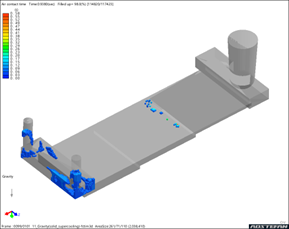Prediction of Slag Inclusion Casting Defect in Gravity Die Castings using ADSTEFAN Casting simulation software
Slag inclusions casting defect are non-metallic impurities that can form during the melting and pouring of metal. They typically arise from the reaction of molten metal with oxides formed due to more contact time with air during filling of molten metal during die filling. When these oxides formed become entrapped in the solidifying metal, they can lead to various issues, including reduced mechanical properties, compromised surface finish, and, ultimately, product failure.
More chances of slag inclusion occur at low temperatures and more contact time with oxygen that is present in environment and die. More time metal is exposed to oxygen, more slag is formed by converting in molten metal into oxide form.
Various factors contribute to the formation of slag, including
- Improper gating design.
- Low pouring temperatures.
- Turbulence filling of molten metal.
- Presence of contaminants in the raw materials.
- Inadequate fluxing techniques.
Remedies to avoid slag formation:
- Improved gating design: Proper gating design to be provided to avoid turbulence filling and more contact time with atmosphere to avoid oxide formation during filling.
- Improved Melting and Pouring Techniques: Utilize protective atmospheres in the melting furnace and reduce the exposure time of the molten metal to air.
- Effective Filtration: Incorporate filtration systems in the pouring process to capture slag and non-metallic inclusions.
- Use of Fluxes: Employ appropriate fluxing agents to help collect and remove non-metallic inclusions from the molten metal. Ensure that these fluxes are compatible with the metal being cast.
- Simulation and Modeling: Utilize GDC casting simulation software such as ADSTEFAN to analyze and predict potential casting defect, allowing for Gating optimization and process optimization before actual production.
Through using casting simulation tools such as ADSTEFAN – Hitachi ICS – Japan based software, Design engineer can access flow conditions of molten metal in cavity whether for given conditions and gating design any turbulence is detected in cavity. This early detection helps design team to remodify gating design and reiterate simulations and best conditions and gating design can be selected and followed by die development and shop floor trails.

a. Air contact results in ADSTEFAN simulation software
Above figure demonstrates air contact time of molten metal inside cavity for gravity die casting process with ADSTEFAN simulation software results. Higher contact time with molten metal and air, higher chances of slag inclusion in casting. Design engineer can also validate temperature distribution and filling velocity of molten metal during filling of mold cavity.
Preventive action taken on component by Gating optimization and process parameter optimization to reduce more contact time with air, high filling velocities and thus slag inclusion defect is controlled. This optimization is carried out in ADSTEFAN software and best gating design, and process parameters are considered in shop floor trails thus leading to elimination of slag inclusion defect in shopfloor. By performing corrective actions using ADSTEFAN casting simulation software, we are able to reduce shop floor trails, production, and development time of component.
Recent Posts
- LPDC simulation of alloy wheel to predict the defects produced due to improper die heating.
- Implementing Machine learning on Defect prediction for Investment casting through ADSTEFAN casting simulation software
- Methods for Indian Casting Manufacturers to Overcome Fluctuating Raw material price
- Casting rejection can be controlled, Here are important tips
- Die Casting 4.0 – Casting Defect Prediction by Machine Learning for Die casting industries using Casting Simulation Software
- Types of Cooling Lines and Thermal balancing die casting Using ADSTEFAN Casting Simulation Software for Casting gating optimisation & Cooling lines optimization
- Yes! We can perform air entrapment prediction and overcome by air entrapment simulation using ADSTEFAN casting simulation software. Here is how we can do
- Are You Facing Challenges in Utilizing Casting Simulation Software? Here’s How to Overcome Them
- Better practice for effective utilization of simulation software
- More Yield, Fewer Defects – How ADSTEFAN helps to Transforms Gating Design! – Case study on Steel Valve body castings